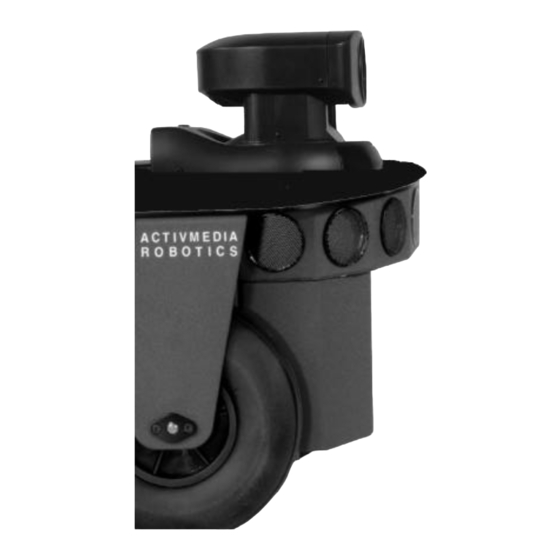
Pioneer 2 Manual
Ptz robotic camera
Hide thumbs
Also See for 2:
- Installation manual (65 pages) ,
- Operating instructions, quick start manual (92 pages)
Advertisement
Quick Links
Download this manual
See also:
Installation Manual
Advertisement

Summary of Contents for Pioneer 2
- Page 1 Pioneer M O B I L E R O B O T S with Pioneer Server Operating System Software PTZ Robotic Camera For Pioneer 2...
- Page 2 ActivMedia, Inc. The software on disk and which accompany the robot or are available for network download by Pioneer Mobile Robot customers, are solely owned and copyrighted by Kurt Konolige, Videre Designs, SRI International, Inc.
-
Page 3: Table Of Contents
Contents Introduction ...1 PTZ Components... 1 PTZ Accessories ... 1 Where to get PTZ System Software ... 2 Related Resources... 2 Hardware Installation...3 Mounting the Camera ... 3 Power/Signal Cables and Connectors ... 3 Came with Robot ... 3 FTVS/Video Side Panel... 4 Serial Communications ... -
Page 5: Introduction
System (PTZ-Fast Track Vision System). And, either capture and digitize the video signal with an onboard frame grabber in your Pioneer 2 EBX computer (PTZ Custom Vision), or send it offboard with an audio/video (A/V) radio system to a frame grabber in a basestation for real-time video surveillance (PTZ Surveillance System) and for you own vision research. -
Page 6: Where To Get Ptz System Software
The PTZ Robotic Camera for Pioneer depends on a working knowledge of your Pioneer Mobile Robot and the Pioneer 2 Operating System software (P2OS). Consult your Pioneer 2 Operation Manual for details. Obtain copies of the latest Pioneer manuals (this document, too) from our Internet website: http://robots.activmedia.com/docs... -
Page 7: Hardware Installation
The PTZ camera comes detached from the robot for safe shipment. We recommend mounting the camera to the front of the robot, centered on top of the Console (Figure 2-1). We have prepared the Pioneer 2 Console with mounting holes, and include the mounting screws with the PTZ camera installation kit. But do not feel obliged to mount it there—the camera may be mounted to any convenient location on the robot. -
Page 8: Ftvs/Video Side Panel
With a separate cable, plug into the RCA Video signal connector 1 or 2 on the side panel and the other end into a NTSC or PAL (respective of the camera) monitor. You should see a full-color image. Use the hand-held controller that comes with the camera to test the pan, tilt, and zoom features. -
Page 9: Ptz System Software
P2OS automatically packages the argument and shunts it through the AUX serial port on the Pioneer 2 microcontroller to the VISCA Input port of the camera. Currently, communications is one-way command-only there is no way to verify camera position or to take advantage of the camera's built-in tracking algorithms through P2OS. -
Page 10: Ptz With Saphira
/makefile PTZ with Saphira The Saphira C-language-based application development environment automatically manages Pioneer communications and P2OS command packets. The PTZ System software includes Saphira functions and related arguments to create Saphira-mediated client applications for control of the PTZ Robotic Camera (Table 3-1). - Page 11 sfPTZCamPan(-95); wait 20; sfMessage("Tilt up ..."); sfPTZCamTilt(20); wait 20; sfMessage("Tilt down ..."); sfPTZCamTilt(-20); wait 20; sfMessage("Reset and zoom in ..."); sfPTZCamPanTilt(0,0); wait 10; sfPTZCamZoom(1023); wait 20; sfMessage("Zoom out ..."); sfPTZCamZoom(0); wait 20; sfMessage("Bye!"); /* Here's where ptzdemo begins... */ start PTZDemo; /* Run the demo */...
-
Page 12: Appendix A
460 TV lines NTSC; 450 TV lines PAL Vertical Resolution 350 TV lines NTSC; 400 TV lines PAL Lens 12X Zoom, f=5.4 - 64.8 mm; F=1.8 - 2.7 Angle of View (H) 48.8 degrees (wide angle) - 4.3 degrees (telephoto) Angle of View (V) 37.6 degrees (wide angle) - 3.3 degrees (telephoto) -
Page 13: Warranty & Liabilities
Warranty & Liabilities Your Pioneer is fully warranted against defective parts or assembly for one year, and the PTZ System for 90 days after it is shipped to you from the factory. This warranty explicitly does not include damage from shipping or from abuse or inappropriate operation, such as if the robot is allowed to tumble or fall off a ledge, or if it is overloaded with heavy objects. - Page 14 44 Concord Street Peterborough, NH 03458 (603) 924-9100 (603) 924-2184 fax http://www.activmedia.com/robots...


